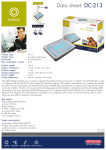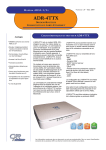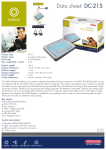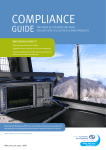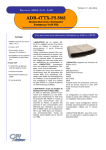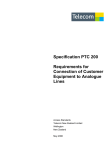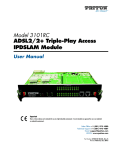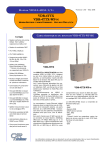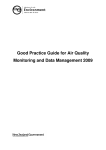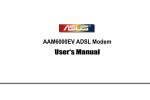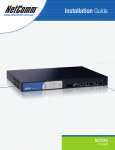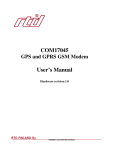Download PTC 273 Requirements for ADSL2+ CPE ()
Transcript
SPECIFICATION PTC 273:2007 REQUIREMENTS FOR CONNECTION OF ADSL CPE TO THE TELECOM NETWORK Draft for public comment Telecom New Zealand April 2007 April 20 2007 2/21 PTC273 CONTENTS Telecom Disclaimer 4 1. INTRODUCTION 5 1.1. Purpose of this document 5 1.2. Goals of CPE qualification 5 1.3. Field Impact 6 2. DEFINITIONS 7 3. SCOPE 8 4. REFERENCE MODELS 9 5. GENERAL REQUIREMENTS 10 5.1 Supplier Information 6. TELECOM SPECIFIC REQUIREMENTS AND TESTS 10 11 6.1 CPE identification test 11 6.2 PSD compliance test 13 6.3 Basic Performance test 17 6.4 Electrical Safety 18 6.5 EMC 19 6.6 Compatibility with Voice Services on the same line 20 6.7 User Instructions 21 Referenced documents International standards [1] Network and Customer Installation Interfaces – ADSL Metallic Interface ANSI T1.413, 1998 [2] Asymmetric digital subscriber Line (ADSL) transceivers. ITU G.992.1 (G.dmt),June 1999 Further completed with all Corrigenda and Amendments until December 2003. [3] Splitterless Asymmetric Digital Subscriber Line (ADSL) Transceivers ITU G.992.2 (G.lite), June 1999 [4] Asymmetric digital subscriber Line (ADSL) transceivers 2. ITU G.992.3 (G.dmt.bis), January 2005. Further completed with Amendments 1 (Sept 05), 2 (Mar 06) and 3 (Nov 06). [5] Splitterless Asymmetric digital subscriber Line (ADSL) transceivers 2. ITU G.992.4 (G.lite.bis), July 2002. [6] Asymmetric digital subscriber Line (ADSL) transceivers - Extended bandwidth ADSL2 (ADSL2+). ITU G.992.5, January 2005. Further completed with Amendments 1 (Jul 05), 2 (Jun 06) and 3 (Nov 06). April 20 2007 3/21 PTC273 [7] Test Procedures for Digital Subscriber Line (DSL) Transceivers ITU G.996.1 (G.test), February 2001. Completed by Erratum 1 (Jan 03) and Amendment 1 (Mar 03) [8] Physical layer management for digital subscriber line (DSL) transceivers ITU G.997.1 (G.ploam), May 2003 Further completed with all Corrigenda and Amendments until November 2006. [9] Handshake procedures for digital subscriber line (DSL) transceivers ITU G.994.1 (G.hs), May 2003 Further completed with all Corrigenda and Amendments until November 2006. [10] Asymmetric Digital Subscriber Line (ADSL) - European specific requirements ETSI TS 101 388 V1.3.1, May 2002 [11] ADSL Interoperability test plan Technical report DSL Forum TR-067, May 2004 [12] ADSL2/ADSL2+ Performance Plan Interoperability test plan Technical report DSL Forum TR-100, March 2007 Telecom PTC documents [13] Specification PTC 270: 2000 Interim Arrangements for ADSL CPE – Provisional Telepermits [14] Specification PTC 280: 2001 Interim Telecom Requirements for Customer-connected ADSL Line Filters April 20 2007 4/21 PTC273 TELECOM DISCLAIMER While every care has been taken, Telecom nevertheless makes no representation or warranty, express or implied, with respect to the sufficiency, accuracy, or utility of any information or opinion contained in this draft Specification. Telecom expressly advises that the use of or reliance on such information is at the risk of the person concerned. Telecom shall not be liable for any loss (including consequential loss) damage or injury incurred by any person or organisation arising out of the sufficiency, accuracy, or utility of any such information or opinion. It must be stressed that there is no guarantee of full or continued inter-operability between Telecom’s network and products granted provisional Telepermits under the terms of this Specification. In addition, any inter-operability cannot be guaranteed under all operating conditions likely to be encountered on the Telecom network. April 20 2007 5/21 PTC273 1. INTRODUCTION 1.1. Purpose of this document This document presents the minimum conditions to be met by ADSL customer equipment for connection to Telecom’s ADSL over POTS network. This specification is one of two specifications covering ADSL CPE, and covers the basic requirements for "permission to connect" to the Telecom Network. This specification replaces PTC270:2000. A companion Specification, PTC275, covers the more extensive requirements for interoperability. In general, compliance to this specification will not guarantee interoperability between CPE and DSLAM equipment in all circumstances that can occur in the Telecom network. However, functional testing does form part of this specification so there can a reasonable expectation that CPE meeting the requirements will perform adequately on the network. If field experiences with qualified CPE reveal sources of non-interoperability Telecom reserves the right to cancel the Telepermit subject to full interoperability testing being satisfactorily performed. Should general interoperability problems be found, Telecom reserves the right to amend either this Specification or the Interoperability specification as appropriate. 1.2 Goals of CPE qualification The basic purpose of only using qualified ADSL CPE equipment in its network, is to allow Telecom to fulfil its commitments both to its end-users as service provider as to its ISP customers as wholesale provider, to offer performing and reliable service in a costeffective way. The arrival of this new PTC coincides with the introduction of ADSL2plus in the network. Offering unconstrained bitrate services over ADSL2plus will raise the end-user’s broadband experiences considerably. Furthermore, it will enable ISP’s to introduce new, competitive service packages further addressing end-user needs. At the same time, boosting end-user service offering will raise the bar for all equipment used to deliver the new services. Years of experience with ADSL deployment have unveiled the pitfalls and issues related to ADSL deployment. As with communications systems in general the ultimate performance limiting factor is noise. This is closely related to signal attenuation, as even in an otherwise electrical quiet environment a signal is attenuated with distance to the point that it is indistinguishable from thermal noise which is a function of receiver bandwidth and temperature. Given this ultimate limit, performance is further limited by induced noise from other sources between the ATU-C and the ATU-R. For example: • Interference between different telecommunication equipment (crosstalk), negatively impacting performance when more systems are deployed in the same cable binders. • Bad in-house wiring practices such as untwisted cable, unbalanced wires (e.g. 3wire), loose connections etc leading to signal distortion and even interruption and/or environmental noise pick-up affecting both performance and stability (service interruptions and packet loss). April 20 2007 6/21 PTC273 1.3 Field impact Telecom cannot guarantee absolutely that compliance to all requirements listed in this document will not cause any operational problems when deployed in the field. The fulfilment of this specification has merely to be considered as a baseline and minimal set of features for offering reliable ADSL connectivity. April 20 2007 7/21 PTC273 2 Definitions ADSL1: This term groups all “legacy” ADSL standards, i.e. ANSI T1.413 Issue 2, ITU G.992.1 (G.dmt,) and ITU G.992.2 (G.lite,). ADSL2: Groups all “new” ADSL standards, i.e. G.992.3 (G.dmt.bis) and G.992.5 (G.lite.bis). eoc Embedded Operations Channel: Channel used for signalling control information between ATU-C and ATU-R. Interoperability: Two pieces of equipment are dynamically interoperable if they implement a common and compatible set of features, functions and options and can demonstrate satisfactory mutual communication in a real network architecture environment as performance test conditions are varied and exercised. Multi-ADSL: Indicates the capability of DSLAM or CPE to operate both according to ADSL1 as to ADSL2 specification. Operation Mode: Specific mode out of all up-to-date defined ADSL standards. The set of operation modes considered in this PTC is listed in section 3 of this Specification. Auto-mode: Concept where DSLAM and CPE automatically select best-suited operation mode out of list of enabled ones, that optimized performance for the measured loop conditions. April 20 2007 8/21 PTC273 3. Scope This PTC replaces PTC270:2000 for all new ADSL CPE equipment to obtain Telepermit for connection Telecom’s DSL access network. ADSL CPE that in the past obtained Telepermit based on PTC270:2000, will keep their right to be deployed in the Telecom network within the limits of operation as were valid during period of validity of the PTC270:2000. This type of access grant will be referred to as Restricted Telepermit. This means they will continue to be able to connect to plain ADSL (G.992.1 or ANSI T1.413 Issue 2) although Telecom will not support applications other than high-speed Internet access type of services. On the other hand, currently qualified CPE that are supporting ADSL2plus, can reapply for Telepermit according to new PTC, and if successfully passing, will obtain Full Telepermit. All new ADSL CPE types will be required to support following list of operation modes: • ADSL2plus over POTS – G.992.5 Annex A • ADSL2 over POTS – G.992.3 Annex A • READSL2 over POTS – G.992.3 Annex L (M1) • ADSL1 over POTS (G.992.1 Annex A and ANSI T1.413 Issue 2) Testing against the requirements of this specification will be performed on a Multi-ADSL DSLAM, supporting all of above indicated operation modes. This Specification only covers DSL physical layer requirements. Other requirements, like higher-layer protocols to be supported, in-house networking interfaces, TR-067 compliance, and so on, fall outside the scope of this document. Finally, this Specification only covers requirements put on the CPE devices themselves. Requirements on filters and/or central splitters, wiring practices and other fall outside the scope of this Specification. April 20 2007 9/21 PTC273 4. REFERENCE MODELS TNZ PROFILES The Multi-ADSL DSLAM will beset to the following profile(s) for testing. Default profile for Multi-ADSL DSLAM ports : Datarates (min-planned-max) Max. Interl. Delay Min. INP Noise Margins TNZ_MM_Unlimited_NM12dB_interleaved Upstream Downstream 32-600-1200 kbps 32-16000-24000 kbps 16 ms 2 symbols 0-12-Inf(51.1) 16 ms 2 symbols 0-12-Inf(51.1) 12 dBm - 40 dBm/Hz -37 dBm/Hz -40 dBm/Hz No bands configured None Disabled 20.4 dBm -38 dBm/Hz -32.9 dBm/Hz -38 dBm/Hz No, default CO mask (min-target-max) Max ATP Max ADSL1/2 NOM READSL2 PSD ADSL2plus Cabinet Mask RFI bands Carrier Masking Upstream Power Back-off Allowed Operating modes G.992.5 Annex A G.992.3 Annex A, L(M1) G.992.1 Annex A T1.413 Issue 2 None NA April 20 2007 10/21 PTC273 5. GENERAL REQUIREMENTS 5.1 Supplier Information Test Item CPE General Information vendor information HW version SW version Chipset (Vendor, HW and Firmware) ADSL Characteristics supported max rates - downstream supported max rates – upstream Supported INP values used duplex procedure (FDD, EC) Support of S = ½ Support of trellis Support of bit swap Number of latency paths Power Cut Back implemented? (yes/no) dying gasp (yes/no) Other Characteristics ATM supported STM supported TR-069 supported Compliance April 20 2007 11/21 PTC273 6. TELECOM SPECIFIC REQUIREMENTS AND TESTS 6.1. CPE identification test 6.1.1 Requirements (1) It shall be possible to uniquely identify the CPE through the combination of modem vendor information (as defined in G.994.1) and system vendor information (in eoc channel, see e.g. G.992.3). (2) The CPE manufacturer shall ensure that the system vendor information is correctly filled in. This information should be easy to interpret. The manufacturer shall describe its methodology of linking system vendor info with actual CPE types. The methodology should link system vendor info with both HW and firmware versions of the CPE. (3) The CPE shall at least support following operation modes G.992.5 Annex A, G.992.3 Annex A, G.992.3 Annex L Mask 1, G.992.1 Annex A. (4) By default, the CPE shall indicate all operating modes it supports in G.994.1 CLR message. (5) Operation modes should not be enabled/disabled by the end-user (via any vendorspecific interface between PC and CPE) but should by default all be allowed. It is up to the DSLAM and the configured profile to select the appropriate operation mode out of the list of available modes. The CPE shall follow the operation mode imposed by the DSLAM. 6.1.2 Test rationale The ability to identify CPE types in invaluable for diagnosing faults. Easily rectified problems such as running out of date firmware can be easily identified remotely. Also should interoperability problems occur with specific CPE models, this can easily be identified, and communicated back to the Telepermit holder. 6.1.3 Test procedure 1. Bring the test port out of service. Configure the test port with default profile. Power cycle the CPE. 2. Bring the test port in service. Wait until the modem has trained. 3. Retrieve following data on the DSLAM: Type Parameter Far-End System Vendor Identification vendor Id Far-End operation mode capability list • version number serial number Number of bytes 8 16 32 Bitmap Reference G.994.1 par G.992.3 par 9.3.3.1 9.4.1.4 G.992.3 par 9.4.1.4 G.994.1 par 9.4 (SIF) The test has to be power-cycled (step 1) too ensure it is not keeping history data. It is allowed that the CPE uses so-called “warm init” by immediately sending MS from second initialisation on. April 20 2007 12/21 PTC273 Pass/Fail criteria Test is successful if: (a) Operation mode capability list at least indicates the modes required in 6.1.3(3). (b) Modem and system vendor information of the CPE are available, filled in correctly and in line with information on identification strategy provided by the vendor to Telecom. • This initial test is merely informational for Telecom to identify the CPE under test. Telecom has the right to request the CPE vendor to change/update the vendor information in case it is ambiguous, incomplete or same as other equipment already deployed in the Telecom network. Number of tests 1 initialisation April 20 2007 13/21 PTC273 6.2. PSD compliance test 6.2.2 Requirements (1) When operating in ADSL2plus mode, transmit spectrum of CPE shall comply to G.992.5 Annex A.2.2 (ATU-R upstream transmit spectral mask) (2) When operating in ADSL2 Annex A mode, transmit spectrum of CPE shall comply to G.992.3 Annex A.2.2 (ATU-R upstream transmit spectral mask) (3) When operating in READSL2 M1 mode, transmit spectrum of CPE shall comply to G.992.3 Annex L.2.2 (ATU-R upstream transmit spectral mask 1 for reach-extended operation) (4) When operating in ADSL1 Annex A mode, transmit spectrum of CPE shall comply to G.992.3 Annex A.2.2 (ATU-R upstream transmit spectral mask) • G.992.3 mask is more strict for OOB than ADSL1, and thus less impacting ADSL2plus and HDB3 on frequencies above 1.1 Mhz. Telecom requires to have same OOB PSD when operated in ADSL1 operation mode. PSD (dBm/Hz) -32.9 dBm/Hz peak PSD -34.5 dBm/Hz peak PSD 22.13 dB/octave -72 dB/octave 21.5 dB/octave -48 dB/octave peak PSD, RBW = 1 MHz -97.5 peak +15 dBrn 0-4 kHz -90 dBm/Hz peak PSD, RBW = 10kHz -100 dBm/Hz peak PSD, RBW = 10kHz -91.3 dBm/Hz -93.2 dBm/Hz -110 dBm/Hz -92.5 dBm/Hz 4 25.875 103.5 -112 dBm/Hz 181.7 307 686 12211411 1630 5275 138 243 G992.5 (ADSL2+) G992.3 (ADSL2, ADSL1) G992.3 (ADSL2 Annex L Mask 1) Figure 6.2.2 ATU-R Transmitter PSD Frequency Requirement Measurement conditions (kHz) 0-4 -75 dBm Total power (0 - 4 kHz) into 600 Ohms -97.5 dBm/Hz RBW 12.5 Hz into 100 Ohms Table 6.2.2.1 0 - 4 kHz requirement for all modulations 12000 Frequency (kHz) April 20 2007 14/21 Frequency (kHz) 4 25.875 138 243 686 12000 PSD Limit (dBm/Hz) -92.5 dBm/Hz -34.5 dBm/Hz -34.5 dBm/Hz -93.2 dBm/Hz -100 dBm/Hz -100 dBm/Hz Frequency (kHz) 1411 1630 5275 12000 PSD Limit (dBm/Hz) -100 dBm/Hz -110 dBm/Hz -112 dBm/Hz -112 dBm/Hz RBW Impedance 100 Hz 100 Hz 10 kHz 100 Ohms 10 kHz 10 kHz 10 kHz RBW Impedance 1 MHz 1 MHz 100 Ohms 1 MHz 1 MHz Table 6.2.2.2 Requirements for G992.5 Annex A (ADSL2+) Frequency (kHz) 4 25.875 138 307 12000 PSD Limit (dBm/Hz) -92.5 dBm/Hz -34.5 dBm/Hz -34.5 dBm/Hz -90 dBm/Hz -90 dBm/Hz Frequency (kHz) 1221 1630 12000 PSD Limit (dBm/Hz) -90 dBm/Hz -110 dBm/Hz -110 dBm/Hz RBW Impedance 100 Hz 100 Hz 10 kHz 100 Ohms 10 kHz 10 kHz RBW Impedance 1 MHz 1 MHz 100 Ohms 1 MHz Table 6.2.2.3 Requirements for G992.3 Annex A (ADSL2, ADSL1)) Frequency (kHz) 4 25.875 103.5 181.7 686 12000 PSD Limit (dBm/Hz) -92.5 dBm/Hz -32.9 dBm/Hz -32.9 dBm/Hz -91.3 dBm/Hz -100 dBm/Hz -100 dBm/Hz Frequency (kHz) 1411 1630 5275 12000 PSD Limit (dBm/Hz) -100 dBm/Hz -110 dBm/Hz -112 dBm/Hz -112 dBm/Hz RBW Impedance 100 Hz 100 Hz 10 kHz 100 Ohms 10 kHz 10 kHz 10 kHz RBW Impedance 1 MHz 1 MHz 100 Ohms 1 MHz 1 MHz Table 6.2.2.4 Requirements for G992.3 Annex L (READSL2 (M1) PTC273 April 20 2007 15/21 PTC273 26.2.3 Test rationale Compliance to spectral masks is required to limit interference with other services using the same cable. 6.2.4 Test procedure To carry out the following tests, connect the equipment under test to an ATU-C via a suitable resistive attenuator, with a spectrum analyser. See Figure 6.2.4.1 and 6.2.4.2. For the 0-4 kHz measurements, a Telecom splitter should be used (Figure 6.2.4.1) to prevent the much higher power upstream passband overloading the probe. Similarly, at the higher frequencies, a high pass filter may be necessary. The attenuation should be increased until, the ATU-C spectrum is attenuated sufficiently to allow the ATU-R output to be measured. • To measure the ADSL1, ADSL2 Annex A and ADSL2+ spectra, the modems may have to be forced to transmit these specific modulations. ADSL2 AnnexL however cannot be set in the modem, but with sufficient attention, the DSLAM should automatically select this mode. -50 dB 100 : 100 ohm ATU-R Telecom Splitter 0-4 kHz, 600 Ohm Selective Level Meter Figure 6.2.4.1 Setup for testing voice band power ATU-C April 20 2007 16/21 -50 dB 100 : 100 ohm ATU-R PTC273 ATU-C Differential probe Spectrum Analyser Figure 6.2.4.2 Setup for testing above voice band To be verified In-band compliance of mask 4 tests to be performed: ADSL2plus, ADSL2 Annex A, LM1, ADSL1 against Multi-Mode DSLAM April 20 2007 17/21 PTC273 6.3. Basic Performance test 6.3.1 Requirement This test sets the minimum downstream performance to be achieved by the modem on a typical customer line. 6.3.2 Test rationale This test case is designed to give an indication that the modem will connect to a Telecom DSLAM and exceed a minimal data rate. This test is not a comprehensive performance test, but eliminates any product which is not fit for purpose. 6.3.3 Test procedure This test uses Telecom cable between the Test Laboratory and the nearest Telecom ADSL2+ DSLAM. 1. Measure downstream speed of a reference modem 2. Connect modem under test and measure downstream speed 3. Repeat steps 1 and 2 The time between each test shall be not more than 5 minutes 6.3.4 Result The average speed of the two tests of the modem under test shall be not less than 60% of the average speed of the two tests of the reference modem. April 20 2007 18/21 PTC273 6.4. Electrical safety (1) The electrical safety requirements of AS/NZ 60950 shall be complied with by all CPE items covered by this Specification. (2) Test reports to AS/NZ 60950 or its equivalent shall be supplied by a testing laboratory which is either recognised by Office of the Chief Electrical Engineer of the Ministry of Consumer Affairs (a division of the Ministry of Economic Development), or which is accredited by IANZ or one of its affiliated overseas laboratory registration authorities for electrical safety testing. • A considerable proportion of telecommunications equipment now available was originally manufactured for the North American and Japanese markets, where the mains voltage is only 100110 V. Such overseas equipment is often designed with inadequate internal clearances between its components to meet New Zealand electrical safety requirements, which are based on 230 V operation. (3) Any separate external power supply used shall also comply with the requirements of AS/NZ 60950 or its equivalent. (4) Any separate external power supply used shall be suitably labelled so that it is easily and positively identifiable as being associated with the modem. • The power supply is critical to the performance of the modem, and it cannot be substituted for generic power supplies of similar rating. April 20 2007 19/21 PTC273 6.5. EMC compliance (1) The requirements of AS/NZ 55022 (CISPR 22 or its direct overseas equivalent) shall be complied with by all CPE items covered by this Specification. • The New Zealand requirements for general EMC compliance by items of equipment intended to be installed in customer’s premises are the same as those applicable in most overseas countries, including Australia, which most suppliers seem to regard as a single market with New Zealand. As such, test reports acceptable in New Zealand will generally already be available as the result of testing carried out for other markets. (2) It is a regulatory requirement that test reports to AS/NZS 55022 or its equivalent shall be held by suppliers of this class of equipment and that a formal Declaration of Conformity shall be submitted to the Ministry of Economic Development before such products are offered for sale or put into use in this country. April 20 2007 20/21 PTC273 6.6. Compatibility with voiceband services on the same line (1) POTS band requirements apply at the POTS port of the standard Telecom remote POTS splitter. Conformance shall be verified by test in accordance with Annex A of this specification. (2) The line termination of ATU-R shall include a DC isolating capacitor having a one minute voltage rating no less than 400 Vdc, in relation to the voiceband input impedance requirement that the imaginary part shall be in the range -1.1 to -2.0 kohm at 4 kHz. • Reference: G.992.1 Annex A.4.2.1 and A.4.1. (3) The DC resistance at 250 V dc shall not be less than 5 Mohm. (4) The longitudinal balance at the line termination of the ATU-R shall exceed 40 dB over the frequency range 30 kHz to 2208 kHz. • Ref G.992.1 Annex A.4.3.1 (4) Operation in the presence of interference from POTS services The application of POTS network ringing and POTS CPE ring trip shall not cause the modem to re-sync. Test Procedure Using the configuration in Fig 6.6, send 5 cadences of Telecom standard ringing. The line is then looped with the designated AC and DC impedance for 15 seconds, then the loop is removed. After a further period of 15 seconds, the sequence is repeated, 25 times. Figure 6.6 Test Set up for ringing and on-hook/off-hook tests April 20 2007 21/21 PTC273 6.7 User Instructions Clear User Instructions shall be supplied with every modem. These shall be specific to connection to the Telecom network. They may be part of the full user manual or a New Zealand set up supplement. The basic minimum setup data is contained on the Telepermit website at: http://www.telepermit.co.nz/ADSLModemSetUp.html The test laboratory shall set up the modem using the instructions supplied, and note any deficiencies or ambiguities.





















